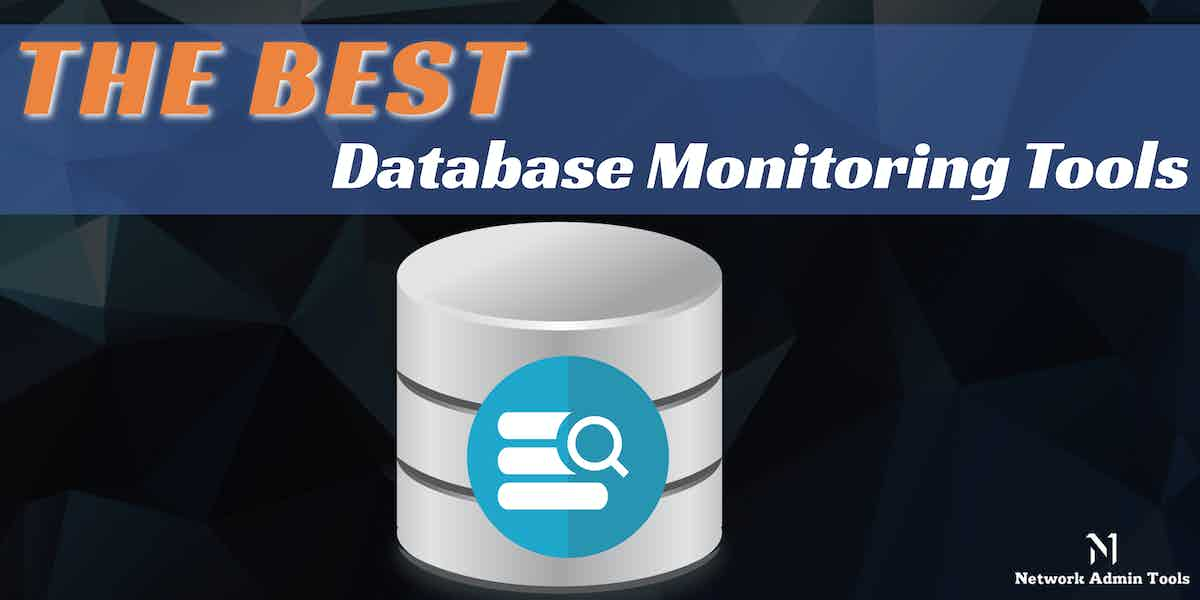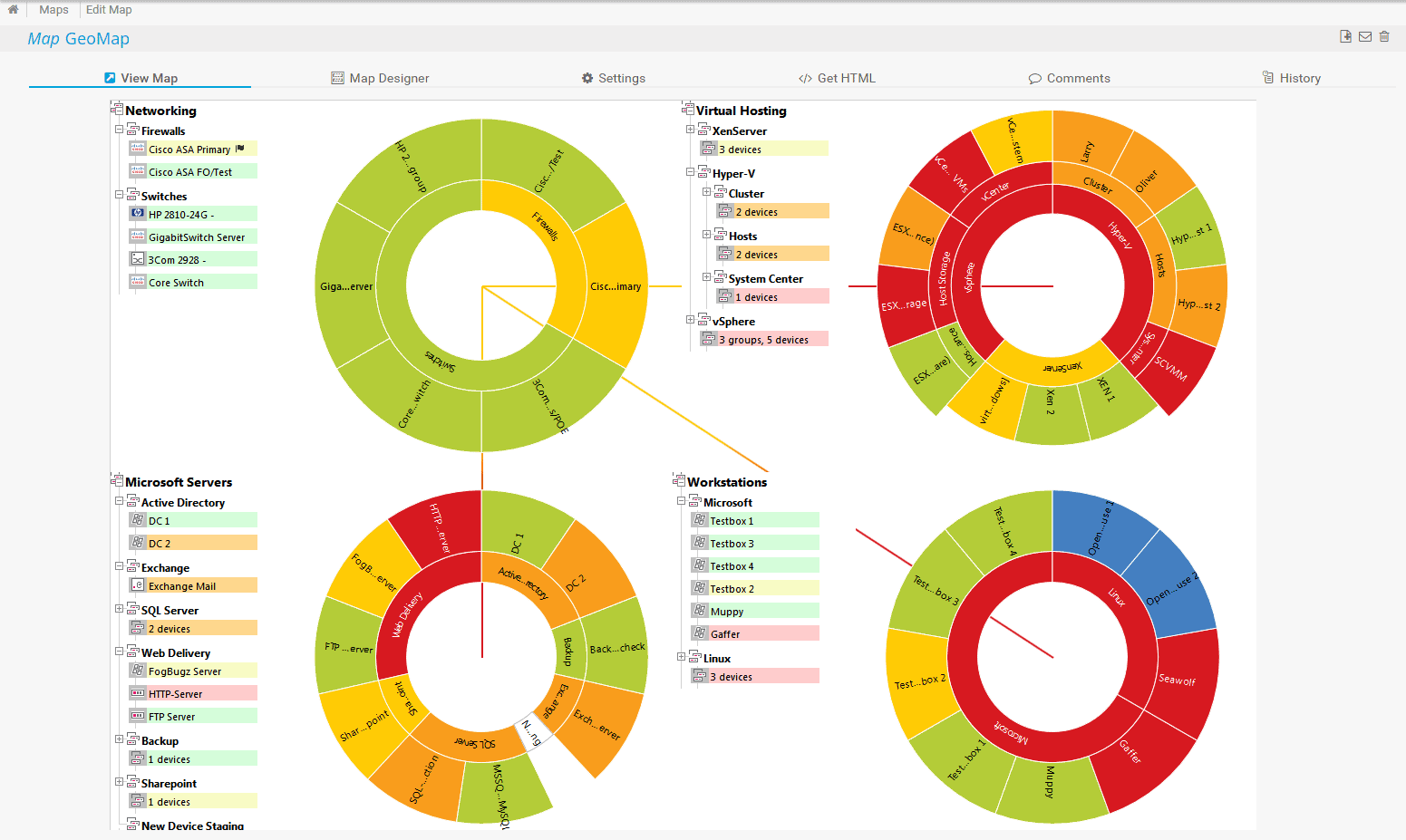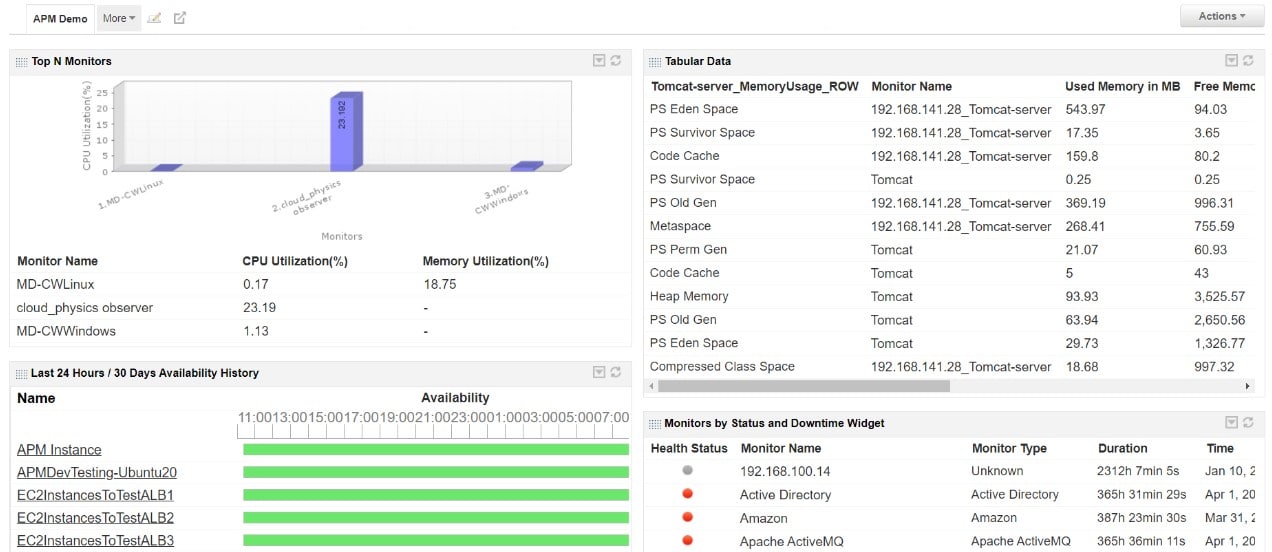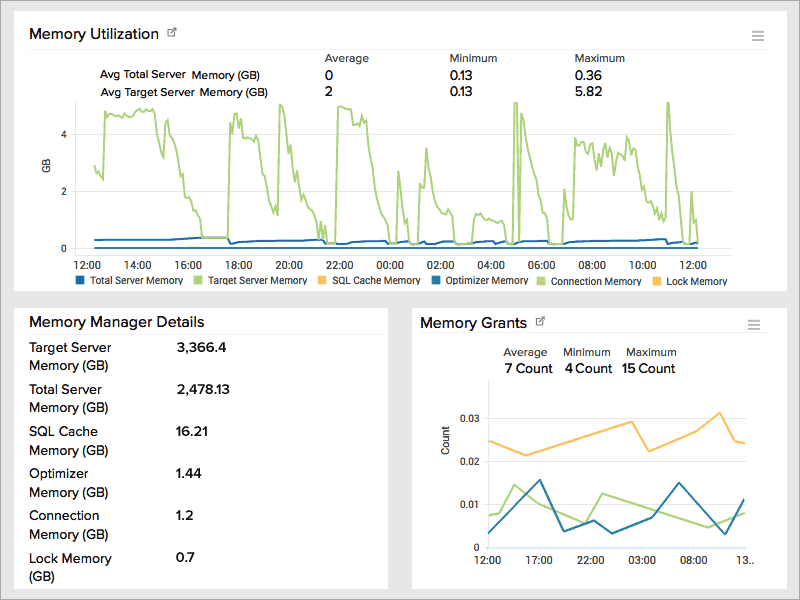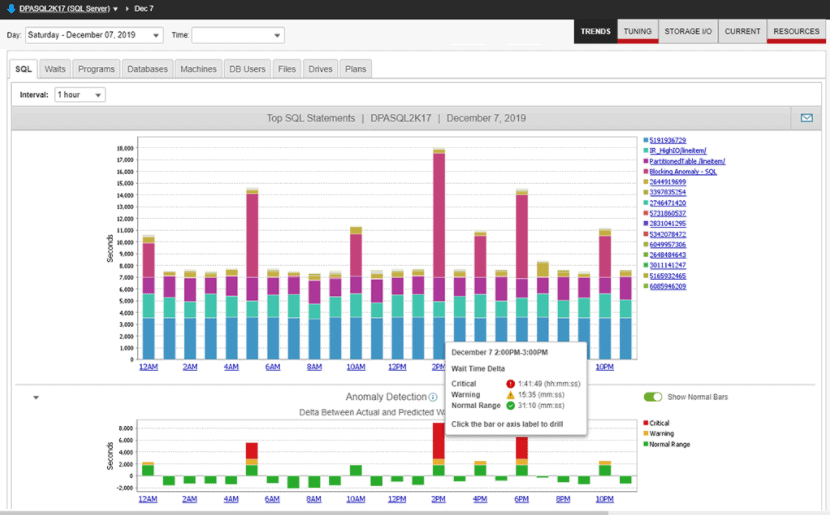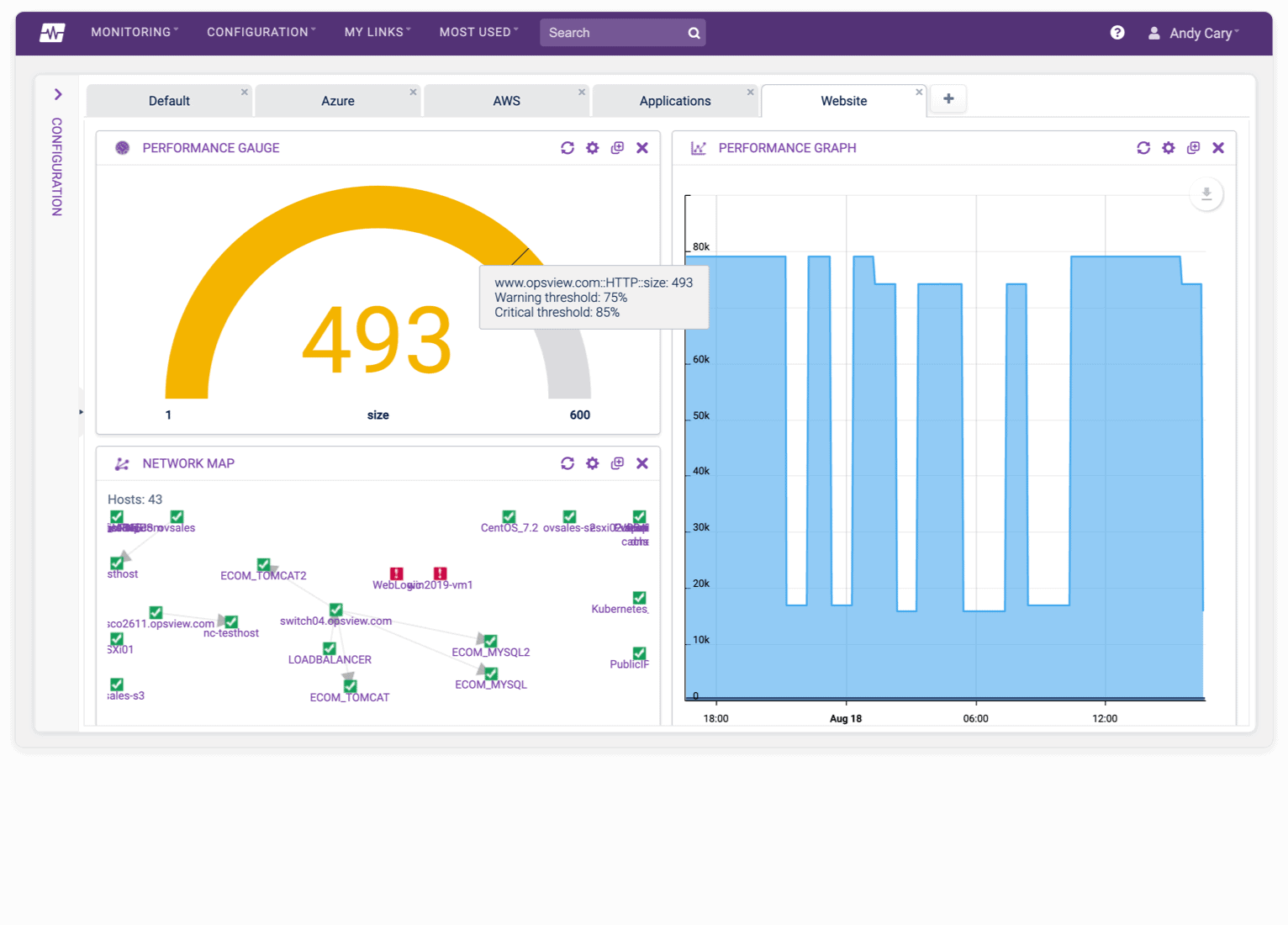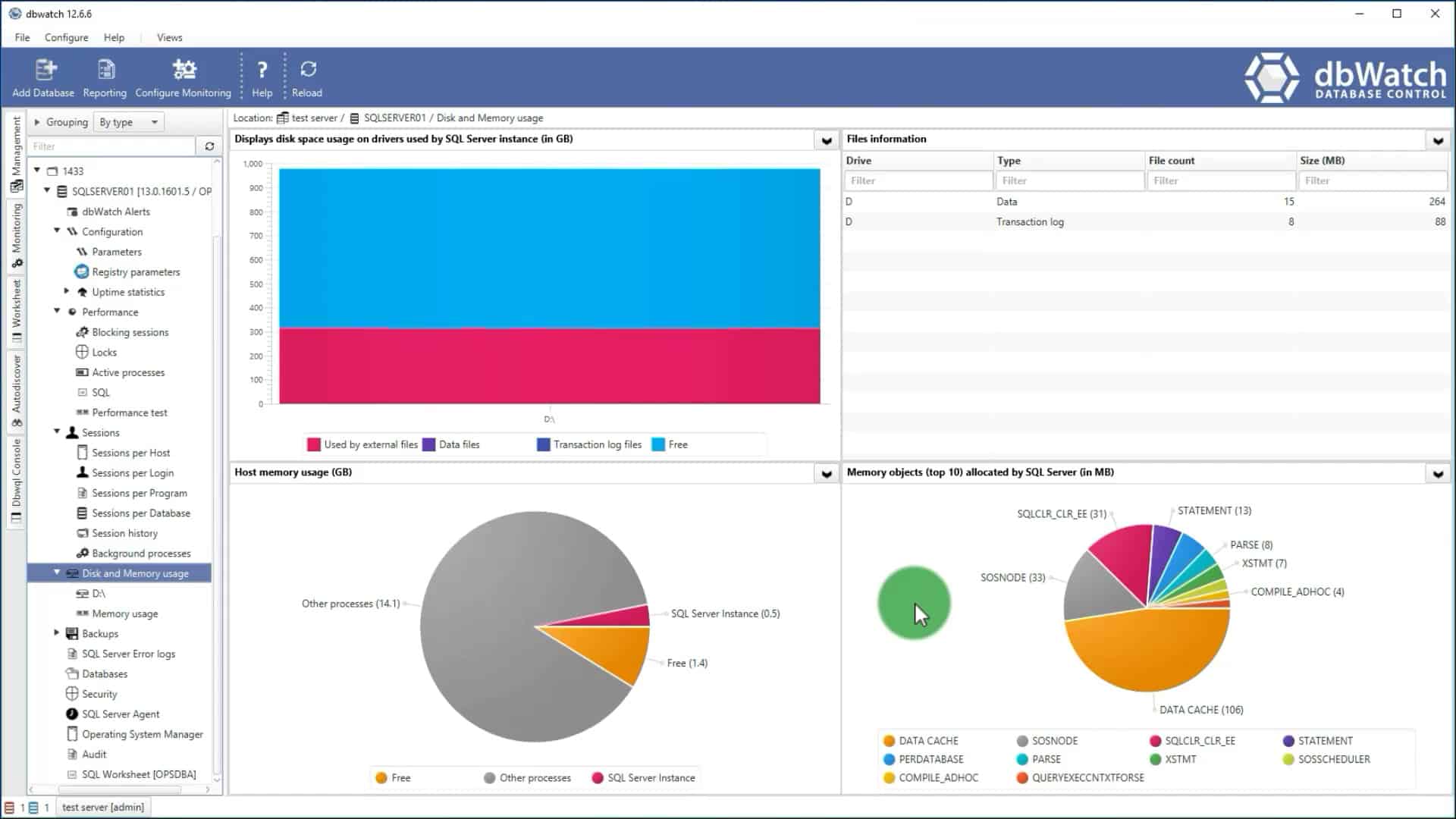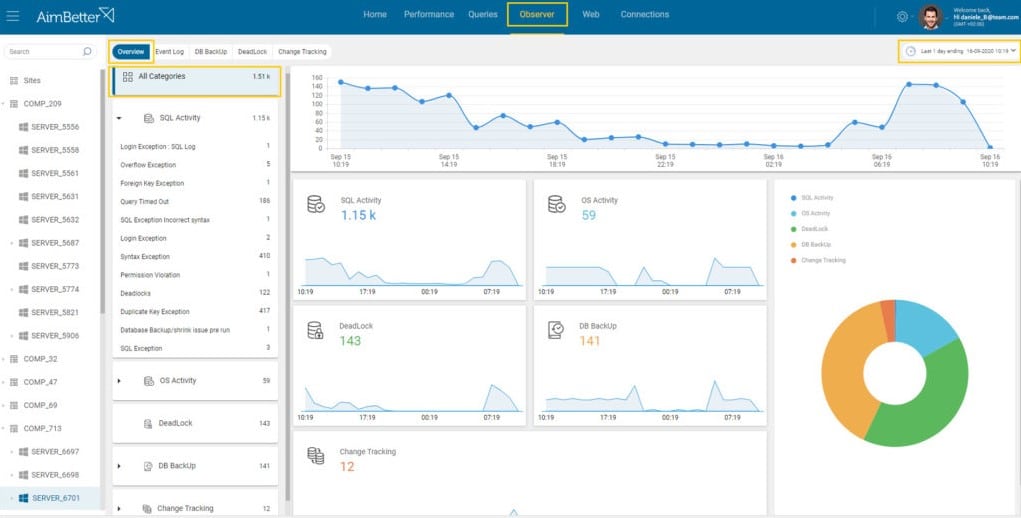Databases are an integral part of every software, and system infrastructure as this is the layer that stores data and retrieves it when needed. Since the process of storage and retrieval is critical for any application, you must ensure that the database is in optimum health and performance at all times. Also, any improvements or failures in its performance can impact the interpretation of one or more of your applications.
Here is our list of the best Database Monitoring Tools:
- Paessler PRTG Network Monitor – EDITOR’S CHOICE A sensor-based monitoring system that can monitor a wide range of devices on your network, including databases. It comes with many sensors explicitly designed for monitoring different databases and to ensure that they work optimally. Get a 30-day free trial.
- ManageEngine Applications Manager – FREE TRIAL This package tracks the performance of software and services, such as Oracle, MySQL, PostgreSQL, and SQL Server databases plus NoSQL and big data systems. Runs on Windows Server, Linux, AWS, and Azure. Start a 30-day free trial.
- Site24x7 Server Monitoring – FREE TRIAL An intuitive and advanced SQL server monitoring tool that ensures the availability and performance of your SQL server. It is designed to deliver optimal SQL performance 24X7. Access the 30-day free trial.
- Datadog A comprehensive way of staying on top of metrics, performance, traces, and logs from your infrastructure. It also monitors the health and performance of your databases at all times, so you can proactively fix issues and resolve deadlocks before they impact your applications.
- SolarWinds Database Performance Analyzer Real monitoring coupled with a host of features such as cross-platform support and AI make it an effective tool for anyone who wants to monitor the underlying database.
- OpsView Designed to provide unified database monitoring across your entire infrastructure which could include both on-premises and cloud systems. It is a comprehensive tool that analyzes all aspects of your database to give the insights you need in real time.
- dbWatch An advanced database monitoring tool that helps you stay on top of the performance of all your databases and sends notifications in real time to alert you to any specific operation.
- AimBetter A cloud-based service that includes the input of database experts and remotely monitors database performance with automated tools. Supervises SQL Server, Oracle, and SAP.
- SQL Power Tools An intelligent and robust solution that analyzes all SQL queries 24X7 to ensure that your database is safe at all times. Plus, it is a zero-impact database monitoring solution that significantly adds to its overall credibility.
Given this criticality of the database performance, it makes sense to monitor it all the time, But this may not be easy given the vastness of the database itself. This is why automated database monitoring tools can come in handy for you.
In this article, we’ll take an in-depth look into the best database monitoring tools available in the market today, so you can decide which of these is the best bet for you. Let’s jump into the specifications and features of each of these tools right away.
The Best Database Monitoring Tools
Methodology for selecting a database monitoring tool
There are many factors to consider when selecting a database monitoring tool including the size of the company, the type of database, the type of work being done, etc.
The type of database is important because it can help determine what kind of monitoring tools are needed. Also, the type of work being done is important because it can help determine which features are most useful for that specific situation.
Apart from these, we have listed a few more criteria that one must consider when reviewing a database monitoring tool.
- Does it support connecting database instances from multiple DBMSs?
- Optimizing and debugging SQL queries
- Monitoring of database and server resources
- Does it offer a risk-free evaluation period with a free trial, demo, or money-back guarantee?
- A fair price that represents the worth of the product and is in line with its quality
- Easy-to-use interface with alert options. How quick is the tool at notifying about resource shortages and declining performance?
- Secure access protocols with numerous user accounts and authentication
1. Paessler PRTG Network Monitor – FREE TRIAL
Paessler PRTG is a sensor-based monitoring system that can monitor a wide range of devices on your network, including databases. It comes with many sensors explicitly designed for monitoring different databases and to ensure that they work optimally.
Key Features
The capabilities of PRTG’s databases sensors are:
- Ensures that database queries are processed within the stipulated time. If it exceeds the set threshold limits, it sends alerts
- Sends alerts if database queries return unexpected values
- Comes with built-in sensors for monitoring many databases like SQL, MySQL, PostgreSQL, and Oracle
- Uses the Active X Data Objects (ADO) interface for monitoring other databases
- You can choose from two sensor types – ones that monitor the database directly and those that monitor the performance of the database
- Many sensors monitor the content of the database
- Performance monitoring sensors are available only for SQL
- Monitors performance through WMI
- Gives the flexibility to set up different metrics
Why do we recommend it?
Paessler PRTG Network Monitor offers a wide range of database-specific sensors, providing comprehensive monitoring and performance analytics for various database systems. Its alert system is particularly robust, notifying you if queries take too long or return unexpected values.
Who is it recommended for?
This monitoring solution is ideal for IT managers and database administrators who need an all-encompassing, sensor-based system for network and database surveillance. It’s especially useful for businesses that use multiple types of databases, given its support for SQL, MySQL, PostgreSQL, and Oracle.
Pros:
- Database of over 300 sensors that helps monitor networks, servers, and applications.
- Provides a centralized location for all data collected by sensors in the network that can be further used to generate reports and graphs.
- Businesses of all sizes can easily use its features like SNMP, packet sniffing, and WMI to monitor connected networks.
- The customizable dashboard shows quick data insights, sends threshold-based alerts, leverages 300+ map objects, and helps create network maps in real time.
- Offers quick deployment and runs a thorough analysis of capacity and updates users when more resources are needed.
Cons:
- Offers various advanced features that new users may find challenging to understand.
Some of the sensors you can choose for monitoring your database.
- Microsoft SQL v2 sensor
- MySQL v2 sensor
- Oracle SQL v2 sensor
- PostgreSQL sensor
- ADO SQL v2 sensor
- WMI Microsoft SQL Server 2008, 2012, 2014, 2016, 2017, and 2019 sensor
The cost depends on the number of sensors you use. Typically, one sensor measures a specific metric in one unit. Here is the breakdown of the cost.
- First 100 sensors – Free
- PRTG 500 – 500 sensors, 1 server installation – $1,750
- PRTG 1000 – 1000 sensors, 1 server installation – $3,200
- PRTG 2500 – 2500 sensors, 1 server installation – $6,500
- PRTG 5000 – 5000 sensors, 1 server installation – $11,500
- PRTG XL1 – Unlimited sensors, 1 server installation – $15,500
- PRTg Enterprise – 20,000 sensors +, unlimited server installations – Custom quote
PRTG is free to use for up to the first 100 sensors. You can start with a 30-day free trial to figure out your network requirements.
2. ManageEngine Applications Manager – FREE TRIAL
ManageEngine Applications Manager is a performance monitoring system for software and services. Its capabilities include database monitoring. It watches relational databases, including Oracle, SQL Server, MySQL, and PostgreSQL. The system can also track activity in NoSQL services, such as Cassandra, Couchbase, and MongoDB, and big data packages.
Key Features
The important features of this package are:
- Performance tracking for multiple databases formed with different systems in the same console
- Drill-down paths to see data on each individual database instance
- Database performance tracking for live systems
- Analysis of database objects in the context of the queries that operate on them
- Database size growth trend analysis
- Capacity planning tools
- Application discovery
- Application dependency mapping that links the database instance to the software that accesses it
- Tracking of server resource capacity and utilization
- Predictions of possible upcoming resource shortages
- Alerts that can be sent by email, SMS, or Help Desk ticket
- Customizable screens
Why do we recommend it?
ManageEngine Applications Manager provides a holistic approach to database and application monitoring, supporting a wide array of database types both in NoSQL and SQL categories. Its comprehensive alerting system, capacity forecasting, and multi-platform support make it a versatile tool for modern IT environments.
Who is it recommended for?
This software is ideal for IT managers and database administrators who are responsible for maintaining a diverse set of databases and applications. It’s particularly useful for businesses utilizing hybrid cloud environments and those in need of capacity planning tools.
Pros:
- Performance monitoring for relational databases, NoSQL databases, big data systems, and key-value stores
- Tracks activity on servers running Windows Server or Linux
- Accesses database activity data on AWS, Azure, and Oracle Cloud
- Implements capacity forecasting
Cons:
- Not a SaaS package
ManageEngine provides three editions for Applications Manager:
- Free
- Professional – from $395 per year
- Enterprise – from $9,595 per year
The Free edition will track databases and is limited to monitoring five assets. Register for the 30-day free trial.
3. Site24x7 Database Monitoring – FREE TRIAL
Site24x7 has an intuitive and advanced SQL server monitoring tool that ensures the availability and performance of your SQL server. It is designed to deliver optimal SQL performance around the clock.
Key Features
Here’s a look at what this database monitoring tool can do for you.
- Mitigates server sprawl
- Gives you complete control over the performance of your database
- Sends instant notifications on failovers
- Provides detailed information about memory and buffers to help you with capacity planning
- Drill down into performance metrics like errors, compilations, and transaction times
- Helps the DevOps team to focus on intense aspects like job locks and latches
- Captures the different database attributes to give you a comprehensive idea of your SQL’s performance
- Finds and analyzes slow and inefficient SQL queries
Why do we recommend it?
Site24x7 Database Monitoring offers 24/7 surveillance of your SQL servers with features that go beyond basic monitoring. From capacity planning to instant notifications on failovers, it provides a comprehensive toolset for maintaining optimal database performance.
Who is it recommended for?
This tool is highly suitable for database administrators and DevOps teams who need around-the-clock monitoring and performance analytics for their SQL servers. It’s also beneficial for organizations looking for a cloud-based solution that requires no additional software installation.
Pros:
- Helps you to keep track of your databases 24/7 without any manual intervention.
- The alert option notifies you when there is an issue with your database or if it goes offline for some reason.
- Provides monitoring solutions for servers, networks, and applications and keeps track of database performance.
- No additional database monitoring software installation is necessary with the product as it is a cloud-based service.
- You can use Site24x7 to track replications, failures, and SQL compilations as well as to monitor SQL execution.
Cons:
- Supports many features, as a result, it may take time to learn and understand.
The starter pack starts at $9 per month, and it covers 10 websites/servers/clouds, 500MB logs, five network monitoring interfaces, two NetFlow analyzer devices, and standard support. You can always include add-ons at extra cost to suit your needs. Start with a 30-day free trial.
4. Datadog Database Monitoring
Datadog’s database monitoring tool is a comprehensive way of staying on top of metrics, performance, traces, and logs from your infrastructure. It also monitors the health and performance of your databases at all times, so you can proactively fix issues and resolve deadlocks before they impact your applications.
Key Features
The key features of Datadog’s database monitoring tool are as follows.
- Monitors essential metrics such as throughput, query execution, connections, buffer pool usage, and more
- Identities issues like slow queries, bottlenecks, errors, full-latency breakdowns, and more
- Ingests log events to identify patterns and the underlying issues that cause them
- Comes with turnkey database monitoring integrations for MongoDB, PostgreSQL, etc.
- Provides critical visibility into the performance of your database
- Explores and identifies dependencies in real-time
- Traces application requests to identify problems in your code
- Seamlessly navigates between different metrics in the same pane
- Comes with out-of-the-box database monitoring dashboards, graphs, and widgets
- Sets intelligent alerts to monitor critical aspects of the database
- Automatically tracks data from auto-scaling infrastructure
- Investigates log services across the entire infrastructure
- Sends real-time alerts
- Correlates database performance metrics to give you a comprehensive view of the state of affairs of your entire infrastructure
- Gives a visual look into the application and database dependencies
- Unifies database monitoring through the entire infrastructure
Why do we recommend it?
Datadog Database Monitoring excels in providing real-time insights into your database’s performance, alongside a robust alerting system. It offers turnkey integrations for various databases like MongoDB and PostgreSQL, making it a versatile choice for comprehensive monitoring.
Who is it recommended for?
This tool is highly recommended for DevOps teams, database administrators, and infrastructure managers who require an in-depth, real-time view of database metrics. Its capabilities in identifying dependencies and tracing application requests make it especially useful for teams focused on optimizing complex, multi-database environments.
Pros:
- Can monitor all database parameters and provide alerts in case of any critical changes.
- Helps in optimizing databases, analyzing queries, and identifying performance bottlenecks.
- Provides detailed analytics, statistics as well and insights on data trends and anomalies that are difficult to identify with standard methods.
- Used for various purposes like monitoring the database performance and stack apps as well as connecting and comparing metrics.
Cons:
- Does not support Oracle integration
- Lacks documentation in some places
Datadog offers three comprehensive plans, and they are:
- Free
- Pro – $15 per host per month
- Enterprise – $23 per host per month
Besides, many add-ons can be included in your plan to get specific monitoring capabilities, and of course, they would cost extra. Click here for a 14-day free trial.
5. SolarWinds Database Performance Analyzer
SolarWinds Database Performance Analyzer (DPA) is a top-notch tool created by experts to stay on top of your databases’ health and performance, perform fine-tuning where needed, analyze its working, get the necessary metrics for analysis, and more. Its real monitoring coupled with a host of features such as cross-platform support and AI make it an effective tool for anyone who wants to monitor the underlying database.
Key Features
Here is a detailed look at the features of SolarWinds DPA.
- Provides cross-platform support for both cloud and on-premises databases
- Its anomaly detection feature is powered by machine learning
- Supports the monitoring of VMware vSphere
- The PerfStack and AppStack integrate well with the Orion platform
- Displays the metrics from Oracle databases on an easy-to-use dashboard
- Analyzes and solves performance issues on Amazon AWS EC2 databases
- Monitors Amazon RDS databases
- Maintains high performance across MySQL databases
- Quickly resolves issues and, in the process, improves user experience
- Improves the SQL performance on Microsoft Azure virtual machines and the underlying SQL databases that may support it
- Detects issues across platforms
- Makes it easy to deploy efficient database development solutions
- Comes with a DevOps tool to improve database management
- Supports streamlined troubleshooting across different databases
- Suggests optimal techniques for enhancing the performance of databases
- Quickly discovers the source of problems in performance
- Comes with a scalable database replication monitoring tool for the most accurate monitoring results
- Identifies and resolves performance issues at the earliest
- Creates intuitive and easy-to-understand reports for improved planning
- Helps with compliance
- Gives you visuals of the impact of hardware and virtualization changes on the database performance
- The purpose-built optimization feature of SolarWinds DPA improves the performance of MySQL databases
- Its multidimensional query analysis gives a snapshot of the performance of PostgreSQL
- Diagnoses and resolves SQL Server deadlocks
- Quickly tracks changes and sends notifications accordingly
- Stays on top of SQL fragmentation slowdowns
- Monitors all databases in real-time
Why do we recommend it?
SolarWinds Database Performance Analyzer excels in real-time monitoring and comprehensive performance insights across various database platforms. Its machine-learning-powered anomaly detection and in-depth query analysis make it indispensable for proactive database management.
Who is it recommended for?
This tool is highly recommended for database administrators who manage multi-platform database environments, especially those in cloud and on-premises setups. It’s also suitable for DevOps teams seeking to integrate database performance metrics into their workflow.
Pros:
- Helps you monitor your database infrastructure, optimize performance, and address issues in real time.
- Has a dashboard for monitoring database activity, and it also monitors the health of your SQL Server instance.
- Enables you to troubleshoot SQL Server performance by identifying which queries are consuming the most resources.
- Provides a comprehensive insight into database performance so that you can identify and diagnose the root cause of performance issues.
- Provides insights into a query execution plan and index usage, so that you can get a clear picture of what is happening inside your database engine.
Cons:
- Difficult to navigate as it is a bit tricky.
Starts at $1,111. Click here for a fully functional free trial.
6. OpsView
OpsView’s database monitoring tools are designed to provide unified database monitoring across your entire infrastructure that could include both on-premise and cloud systems. It is a comprehensive tool that analyzes all aspects of your database to give the insights you need in real-time.
Key Features
Some of the salient features of OpsView’s database monitoring are:
- The MySQL OpsPack monitors 39 performance metrics, including sessions, connects, free blocks, and more
- Enables you to monitor every change
- Its reporting module comes with out-of-the-box reporting modules that can provide a visual snapshot of the database’s performance
- The Oracle OpePack monitors 42 performance metrics
- There are 22 service checks for transactions, wait stats, and other metrics in SQL databases
- Sends immediate notifications when the critical metrics go out of the established thresholds
- Ensures that all database systems and applications perform at optimal levels
- Proactively checks to avoid transaction failures
- Tracks and manages fast proliferating databases
- Works to prevent data loss
- Captures operational metrics for each database class and type
- Quickly discovers and remediates the underlying issue
Why do we recommend it?
OpsView offers a truly unified monitoring solution that covers a broad spectrum of databases, from Oracle and Microsoft SQL to cloud databases like AWS DynamoDB. Its extensive performance metrics and immediate alerting system make it a robust tool for ensuring optimal database performance.
OpsView monitors the following databases
- Oracle
- IBM DB2
- MySQL
- Microsoft SQL
- Amazon RDS
- InfluxDB
- PostgreSQL
- Azure SQL
- Google Cloud MySQL
- AWS DynamoDB
- Etcd
- LDAP
- MongoDB
Who is it recommended for?
This tool is ideal for businesses with a hybrid IT infrastructure that includes both on-premise and cloud databases. It’s also well-suited for IT administrators and database managers who need real-time monitoring and robust reporting capabilities to manage complex, multi-database environments.
Pros:
- Allows users to monitor databases in real-time and find out precisely how their hybrid IT infrastructure and app performance affect the way service is distributed.
- Helps cut manpower costs by handling the network examination on its own.
- If a problem arises, the solution immediately alerts IT administrators.
- Offers reporting, information visualization, and other features as well as smooth integration with new or pre-existing business programs.
Cons:
- Cloud monitoring packs require attention
- The SMB version lacks advanced features
There are two OpsView plans, and they are:
- OpsView Cloud – Ideal for MSPs as it starts at 150 hosts and can scale up to 50,000+ hosts
- Enterprise – Ideal for organizations that want to deploy on-premises. It starts at 300 hosts and scales up to 50,000+ hosts.
Reach out to the sales team for pricing. Click here for a free trial.
7. dbWatch
dbWatch is an advanced database monitoring tool that helps you stay on top of the performance of all your databases and sends notifications in real time to alert you to any specific operation.
Key Features
Below are some of the things that dbWatch can do for you.
- Monitors many types of databases such as SQL Server, Oracle, MySQL, PostgreSQL, Sybase, MariaDB, and more
- Scales well to meet your business needs
- Works well across cloud, on-premises, and hybrid environments
- Automates routine monitoring
- Optimizes the use of available resources
- Enhances the productivity of your DBAs
- Proactively monitors databases to manage risks better
- Analyzes the problem and points to the root-cause
- Reduces cost and complexity
- Automates processes and tasks
- Monitors all instances in a single view
- Drills down through the metrics to check for admin issues
- Creates custom dashboards and reports
- Supports Active Directory and Kerberos
- Allows role-based access
Why do we recommend it?
dbWatch offers extensive database compatibility and excellent scalability, making it an efficient choice for multi-environment monitoring. Its proactive risk management and real-time alerts ensure that you’re always one step ahead in maintaining your databases.
Who is it recommended for?
This tool is perfect for businesses that have a mix of different database types across various environments, including cloud, on-premises, and hybrid. dbWatch is also suitable for DBAs looking to automate routine monitoring tasks and enhance productivity.
Pros:
- Helps manage and track SQLServer and Oracle database servers performance, status, and resources
- You can administer your server from anywhere with dbWatch Control Center.
- With overview and analytics, you can manage every instance directly by seeing the overall condition across all instances
- Allows users to connect to several active dbWatch domains at once
Cons:
- Configuration is a complex process
- Requires expertise in configuration
There are two editions offered by dbWatch.
- Enterprise edition – $490/instance and a minimum of 10 instances
- dbWatch Control Center – $550/instance and a minimum of 10 instances
The above licensing cost is for a year. Click here for a free trial.
8. AimBetter
AimBetter is a cloud-based provider that provides automated monitoring tools plus the services of a team of database experts that you can step up into a fully managed service. The system reaches across the internet to liaise with a local agent program that constantly gathers access and performance data on each database instance.
Key Features
The key features of the AimBetter service are as follows.
- Automated monitoring for SQL Server, Oracle, and SAP
- IIS Web server monitoring
- Monitoring for Windows Server and server resources
- Initial database assessment from an expert
- A team of database experts who manually check performance data
- Advice on tuning database structures to avoid performance issues
- Recommendations on optimizing database objects
- On-call advice
- More than 400 metrics
- Alerts on performance issue discovery
- Data retention for up to 1 year
- Tools for historical analysis
- Access through any Web browser
- Special AimBetter mobile app
- Managed service option
Why do we recommend it?
AimBetter offers a unique blend of automated monitoring tools along with the expertise of a dedicated team, making it a comprehensive database monitoring solution. With more than 400 metrics and data retention up to a year, it excels in performance analysis and troubleshooting.
Who is it recommended for?
This tool is ideal for businesses that not only need automated database monitoring but also want the option of expert advice and managed services. AimBetter is particularly useful for companies using SQL Server, Oracle, and SAP, and those looking to optimize their database structures for better performance.
Pros:
- Creates a unified dashboard that allows you to quickly and thoroughly view all of your company’s database queries on a single screen.
- For up to a year, the tool automatically saves past data to improve comparison query analysis.
- Ability to discover issues and trouble regions and pinpoint their root causes quickly.
- Users can tack 300+ critical system metrics at the server and database level
Cons:
- Do not offer live support
- Offers no on-premise version
AimBetter has a flexible pricing model that is based on your database requirements which assures you won’t be paying for modules and extras that you don’t use or need. This is a cloud service, so you sign up for the service rather than downloading a package. You can request a free trial.
9. SQL Power Tools
SQL Power Tools is an intelligent and robust solution that analyzes all SQL queries 24X7 to ensure that your database is safe at all times. Plus, it is a zero-impact database monitoring solution that significantly adds to its overall credibility.
Key Features
Here’s a look at what SQL Power Tools can do for you.
- Protects sensitive information such as credit cards, government IDs, and more
- Works well on Informix, MariaDB, SWL, Oracle, MySQL, and Sybase
- Complies with GDPR
- Analyzes 100% of SQL activity in real-time o identify problems
- Identifies and shuts down hackers and rogues
- Runs non-intrusively on a proxy server and even on a network tap
- No false-positive data breach alerts are sent
- Comes with dashboards and heatmaps to evaluate the performance
- Sends email alerts when SQL response time is degraded
- Allows you to filter activity over any period
- Reports the average response time every X seconds, where you can configure the X value
- Installs quickly using the product setup wizard
Why do we recommend it?
SQL Power Tools offers robust 24×7 SQL query analysis combined with zero-impact monitoring, making it a highly credible choice for database security and performance. Its real-time analytics and ability to identify and shut down security threats add a layer of protection that’s invaluable in today’s digital landscape.
Who is it recommended for?
This tool is ideal for businesses that have stringent security and compliance requirements, including those that need to adhere to GDPR. It’s especially suited for organizations that handle sensitive information and require real-time analytics to monitor SQL activity. Given its broad database support, it’s a versatile choice for diverse IT environments.
Pros:
- Allows users to explore, query, and visualize data in SQL Server.
- Offers a high-quality experience and enables users to see how your database is doing.
- Provides a GUI interface for the most common tasks of database administration such as managing databases, managing logins, managing jobs, and more.
- Provides integrated security monitoring and auditing that uses behavioral analytics to prevent SQL assaults.
Cons:
- Users may take time to learn the tool and its features
- Offers no support for applications other than SQL
Contact the sales team for a custom quote. Click here for a free trial.
Conclusion
To conclude, database monitoring tools are an essential part of your IT toolkit as they stay on top of the health and performance of your databases at all times. Also, their constant monitoring ensures that even the smallest of anomalies are detected, so they can be fixed before it impacts the larger organization or the end-users. Some of them even come with advanced tools for online security.
The tools we have described in this article are some of the most comprehensive ones available in the market today. We hope such a detailed feature description comes in handy to zero in on the tool that best fits your needs.

